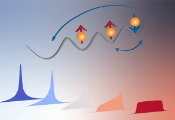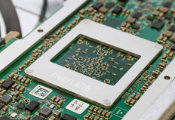Physicists Uncover Behavior in Quantum Superconductors That Provides a New Level of Control
October 14, 2024 -- A new study has uncovered important behavior in the flow of electric current through quantum superconductors, potentially advancing the development of future technologies like quantum computing.

In a paper accepted for publication in Physical Review Letters, the research focuses on Floquet Majorana fermions and their role in a phenomenon called the Josephson effect, which could enable more precise control of quantum-driven computer systems.
The study is co-authored by Babak Seradjeh, Professor of Physics within the College of Arts and Sciences at Indiana University Bloomington, with theoretical physicists Rekha Kumari and Arijit Kundu of the Indian Institute of Technology Kanpur. It is available on the arXiv preprint server.
Potentially revolutionizing quantum computing
Professor Babak and colleagues have addressed a core issue with quantum computers today: instability. This instability is mainly due to something called quantum decoherence, wherein quantum bits, known as qubits, lose their delicate quantum state due to interference from their environment—such as temperature fluctuations or electromagnetic noise.
Quantum computers often require the use of superconductors, which are fabricated from materials that can conduct electricity with zero resistance—meaning, they can carry electric current without losing any energy. However, today's superconductors only work at extremely low temperatures—close to absolute zero.
This makes quantum computers incredibly energy-intensive to keep cold, and thus stable, because when qubits aren't kept cold enough they become even more unstable, which means errors happen faster and more frequently.
The scientific quest for "room-temperature superconductors" is often referred to as the Holy Grail of superconductivity, because the cooling process is so costly and complex. If scientists could develop materials that exhibit superconductivity at room temperature (approximately 20–25°C or 68–77°F), it could revolutionize technology as we know it, leading to lossless power transmission, exponentially faster and more energy-efficient electronics, powerful magnets for applications like MRI machines, and advanced energy storage systems.
What makes Floquet Majorana fermions special for quantum computing?
At the heart of the researchers' study are Majorana fermions, subatomic particles that behave in unique ways; unlike most particles, Majorana fermions are their own antiparticles. (For every type of particle in the universe—such as electrons and protons—there exists a corresponding antiparticle with opposite properties, and this symmetry between particles and antiparticles is a fundamental part of the structure of the universe.)
Researchers posit that Majorana fermions exist in certain materials, like topological superconductors. These differ from regular superconductors in that a topological superconductor has unique, stable quantum states on its surface or edges that are protected by the material's underlying topology—the way its structure is shaped at the quantum level.
These surface states make them resistant to disruptions, which is why they hold potential for developing more stable quantum computers. These special edge states can also host exotic particles like Majorana fermions, which don't exist in regular superconductors.
The researchers explored Majorana fermions in a specific context: superconductors that are periodically driven, meaning, they are exposed to external energy sources that cycle on and off in a repeated pattern. This periodic driving alters the behavior of the Majorana fermions, transforming them into Floquet Majorana fermions (FMFs).
Floquet Majorana fermions can exist in distinct states, changing based on their interaction with the cycling energy source. These FMFs influence the electric current in unique ways, leading to what scientists call the Josephson effect—a quantum phenomenon where current can flow between two superconductors without the need for an applied voltage—that is, the pressure that pushes electricity between two points. This periodic driving of the superconductor is key to maintaining the FMFs and the unusual patterns they create.
In most systems, the current between two superconductors repeats itself at regular intervals. However, with FMFs, a special type of electrical behavior occurs in some advanced superconductors, where the current oscillates at half the normal rate, creating a unique, slower pattern, making the system more stable.
This stability is crucial because it could help improve the performance and reliability of quantum computers, which rely on precise and stable quantum states to process information. In other words, this slower oscillation could make quantum devices more efficient and less vulnerable to disruptions, which is a big challenge in quantum computing today.
Tuning the current with new techniques
One of the key findings revealed by Babak and colleagues' study is that the strength of the Josephson current—the amount of electrical flow—can be tuned using the chemical potential of the superconductors.
Simply stated, the chemical potential acts as a dial that adjusts the properties of the material, and the researchers found that it could be modified by syncing with the frequency of the external energy source driving the system.
This gives scientists a new level of control over quantum materials and opens up possibilities for applications in quantum information processing, where precise manipulation of quantum states is critical. The implications for quantum computing are vast, because the technology relies on manipulating quantum states in a stable and predictable way.
The discovery that Floquet Majorana fermions have unique properties that can be controlled through external drives could help pave the way for building quantum computers that are not only faster, but also more resistant to errors.
And Majorana fermions are particularly exciting to researchers because they are expected to support fault-tolerant quantum computing—that is, where information can be stored and manipulated without being lost to noise or other disturbances.
Although the study is theoretical, the research team confirmed their results through computer simulations, and these findings provide researchers worldwide a roadmap for exploring new, controllable properties in quantum systems.




































